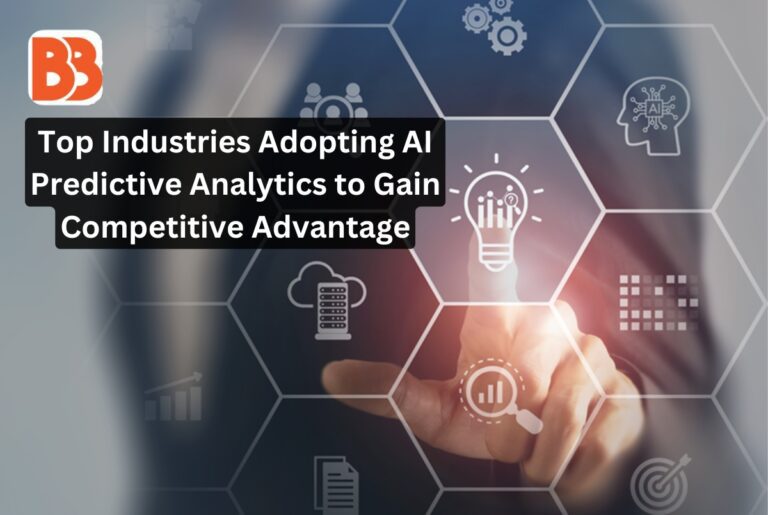Artificial Intelligence (AI) predictive analytics has become a transformative force across industries, allowing businesses to harness vast amounts of data and turn it into actionable insights. By using machine learning algorithms to predict future events based on historical and real-time data, companies gain a competitive advantage in areas such as efficiency, risk management, customer satisfaction, and operational accuracy. Let’s have a look at some of the top industries adopting AI predictive analytics to stay ahead.
Healthcare: Enhancing Patient Care and Operational Efficiency
The healthcare industry is experiencing a major shift as hospitals and clinics leverage AI predictive analytics to improve patient outcomes and streamline operations. Predictive analytics allows healthcare providers to:
- Forecast Patient Outcomes: By analyzing patient data, predictive models help identify high-risk patients, anticipate complications, and plan interventions proactively.
- Optimize Staffing and Resource Allocation: Hospitals use predictive models to forecast patient volume, ensuring adequate staffing levels and reducing wait times.
- Improve Disease Management: For chronic illnesses, predictive analytics assists in tracking patient progress and adjusting treatments accordingly.
The potential benefits are vast, as healthcare providers aim to offer proactive care rather than reactive treatments, reducing hospitalizations and lowering healthcare costs.
Finance and Banking: Reducing Risk and Enhancing Customer Experience
In the finance and banking sector, predictive analytics has emerged as a vital tool for risk management and customer personalization. Banks and financial institutions use AI to:
- Identify Fraudulent Transactions: Predictive analytics models analyze transaction patterns and flag potential fraud before significant damage occurs.
- Enhance Customer Experience: By predicting customer behaviors, banks tailor products and services to individual needs, from personalized loan offers to custom investment suggestions.
- Credit Scoring and Risk Assessment: Predictive analytics provides a more nuanced understanding of a customer’s creditworthiness, often with fewer biases than traditional methods.
The finance industry has been one of the earliest adopters of AI predictive analytics, recognizing its capacity to minimize risk and build stronger customer relationships.
Retail and E-commerce
Retailers and e-commerce platforms are using predictive analytics to understand customer preferences, optimize supply chains, and create personalized shopping experiences. Key applications include:
- Demand Forecasting: Retailers analyze purchasing trends and seasonal factors to anticipate demand, reducing overstock or stock-outs and minimizing losses.
- Customer Personalization: AI models predict what products individual customers are likely to buy, enabling personalized recommendations that increase conversion rates.
- Price Optimization: By analyzing customer purchasing behavior and market trends, retailers can dynamically adjust prices to stay competitive and maximize revenue.
Predictive analytics allows retailers to better manage inventory, improve customer retention, and stay ahead in a highly competitive market.
Manufacturing
Manufacturing is leveraging predictive analytics to monitor machinery, optimize production, and enhance quality control. With predictive maintenance, manufacturers can:
- Prevent Equipment Failure: AI models analyze machine data to detect anomalies, predicting when a part may fail and scheduling maintenance before disruptions occur.
- Optimize Supply Chains: Predictive analytics forecasts demand and manages inventory levels, helping manufacturers reduce costs and respond to market fluctuations.
- Enhance Quality Control: AI detects patterns associated with product defects, enabling real-time adjustments to ensure consistent quality.
Manufacturers are increasingly using predictive analytics to reduce costs, improve product quality, and ensure continuity in operations.
Energy and Utilities
Predictive analytics in the energy sector supports the optimization of resources and management of renewable energy sources. It enables:
- Demand Forecasting and Load Management: Utility companies predict peak energy demands and balance grid load, reducing waste and enhancing efficiency.
- Predictive Maintenance of Equipment: Like manufacturing, the energy sector uses predictive maintenance to prevent outages and maintain equipment.
- Integrating Renewable Energy: Predictive analytics forecasts solar or wind energy generation, improving the reliability of renewable resources on the grid.
With predictive analytics, energy companies can manage resources more efficiently, reduce emissions, and make renewable energy more feasible as a primary power source.
Logistics and Transportation
The logistics and transportation industry depends on predictive analytics to optimize routes, reduce fuel costs, and manage fleets. Applications include:
- Route Optimization: AI algorithms analyze traffic patterns and weather forecasts, helping companies plan the most efficient delivery routes.
- Predictive Maintenance for Fleets: Predictive models monitor vehicle health, preventing breakdowns and extending fleet lifespans.
- Inventory and Demand Forecasting: Logistics companies predict fluctuations in demand, helping them manage inventory levels and storage efficiently.
With AI-driven analytics, logistics companies achieve faster deliveries, lower costs, and greater customer satisfaction.
Telecommunications
Telecommunications companies use predictive analytics to improve network performance, reduce customer churn, and offer personalized services.You can read more about “Understanding Predictive Analytics in Risk Management”
Examples include:
- Network Optimization: Predictive analytics identifies potential network issues, enabling telecom providers to prevent downtime and improve service quality.
- Churn Prediction and Retention: By analyzing usage patterns, companies identify customers likely to cancel and target them with personalized offers.
- Capacity Planning: Predictive models forecast future demand, helping telecom companies expand or adjust their network capacity efficiently.
In a highly competitive market, telecom providers gain an edge by improving network reliability and customer satisfaction.
Conclusion
As data volumes continue to grow, the adoption of AI-powered predictive analytics is accelerating across industries. Companies in healthcare, finance, retail, manufacturing, energy, logistics, and telecommunications are finding new ways to leverage AI to reduce risks, streamline operations. And enhance customer experiences. Predictive analytics offers businesses the ability to anticipate and respond to changes proactively, helping them stay competitive in an increasingly data-driven economy.
The industries embracing AI predictive analytics are likely to lead the way in shaping the future, adapting quickly to market demands and setting a high standard for operational excellence. By investing in predictive analytics, organizations position themselves to capitalize on the insights gained from vast data sources. Transforming challenges into opportunities and staying a step ahead in a competitive landscape.
